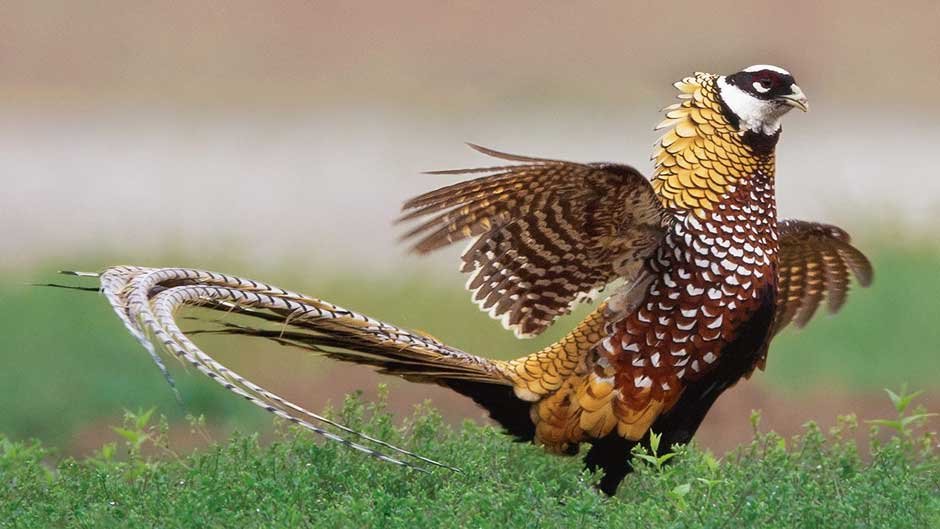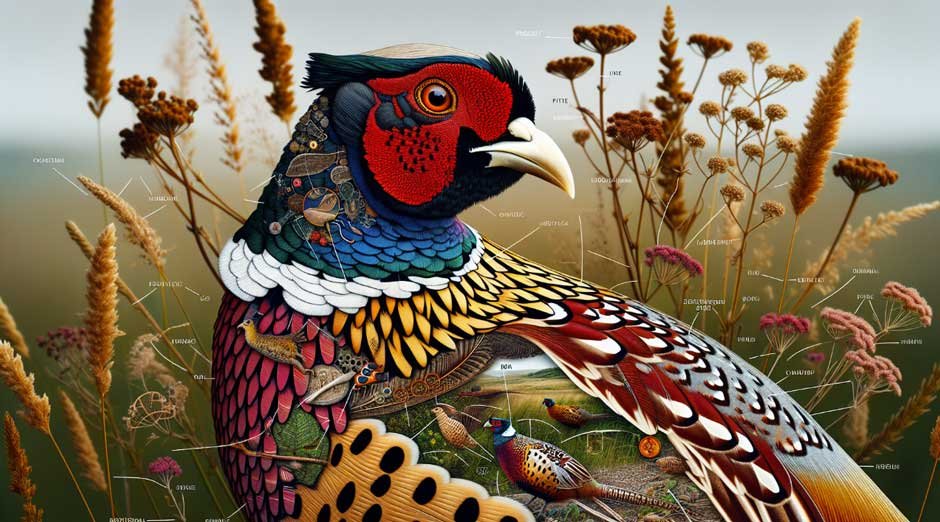The Reeves pheasant, with its striking appearance and intriguing behaviors, has captivated bird enthusiasts and conservationists alike. Known for its vibrant plumage and long tail feathers, this bird not only adds splendor to the avian world but also plays a vital role in its ecosystem. It serves as a fascinating subject for study due to its unique physical characteristics, diverse habitat preferences, and complex behavioral patterns. Understanding the Reeves pheasant is crucial for wildlife conservation efforts, highlighting the importance of preserving their natural habitats and ensuring the survival of the species.
This article delves into the world of the Reeves pheasant, exploring everything from its distinctive physical characteristics to its distribution and habitat. Readers will gain insights into the behavior and diet of these birds, understanding how these aspects contribute to their survival in the wild. The conservation status of the Reeves pheasant will be examined, shedding light on the challenges facing these birds and the efforts being made to protect them. Additionally, a collection of interesting facts will provide a deeper appreciation for this remarkable species. Through this comprehensive overview, the article aims to inform and inspire action towards the conservation of the Reeves pheasant.

Description of Reeves’s Pheasant
Reeves’s pheasant (Syrmaticus reevesii), named after the British naturalist John Reeves who introduced the species to Europe in 1831, is a strikingly large bird endemic to China. This section explores the physical characteristics of both male and female Reeves’s pheasants, their notable features, and some variations in their appearance.
Physical Characteristics of Male Reeves’s Pheasant
The male Reeves’s pheasant is renowned for its impressive size and vibrant plumage. It measures approximately 210 cm (83 inches) in length and weighs around 1,529 g (3.371 lb). One of its most distinctive features is the extremely long silvery white tail, barred with chestnut brown, which can measure up to 2.4 m (7.9 ft). This tail is not just a visual spectacle but also holds the record for the longest natural tail feather of any bird species, as noted in the 2008 edition of Guinness World Records. The body of the male is adorned with scaled golden white and red plumage, and it has grey legs and a brown iris. The facial area is characterized by bare red skin around the eye and a striking white head with a narrow black band across its eyes.
Physical Characteristics of Female Reeves’s Pheasant
Females are considerably smaller, measuring 75 cm (30 inches) in length and weighing 949 g (2.092 lb). Their plumage is predominantly brown with a blackish crown and a buff face. The tail feathers are greyish brown and barred, similar in size to those of a male common pheasant. Despite their less flamboyant coloring, female Reeves’s pheasants carry a subtle elegance that complements the male’s brilliance.
Variations in Plumage
Although there are no known subspecies of Reeves’s pheasant, some variations in plumage do occur. These variations, however, are typically minor and do not significantly alter the general appearance of the species. Both males and females maintain the characteristic features that make them easily identifiable among other pheasant species.
This detailed description of Reeves’s pheasant underscores the unique physical traits that make this species a subject of admiration and study. Their remarkable features not only contribute to their aesthetic value but also reflect the evolutionary adaptations that support their survival in diverse habitats across China.
Physical Characteristics
Male Reeves’s Pheasant
The male Reeves’s pheasant stands out with its remarkable size and stunning plumage. Measuring an impressive 210 cm (83 inches) in length and weighing approximately 1,529 g (3.371 lb), these birds are a sight to behold. Their most notable feature is the incredibly long silvery white tail, which is barred with chestnut brown and can extend up to 2.4 m (7.9 ft) long. This distinctive tail has earned them a spot in the 2008 edition of Guinness World Records for having the longest natural tail feather of any bird species. The body of the male pheasant is adorned with scaled golden white and red plumage, complemented by grey legs and a brown iris. Their facial area features bare red skin around the eye, and a striking white head marked with a narrow black band across its eyes, giving them a distinctive and attractive appearance.
Female Reeves’s Pheasant
In contrast, female Reeves’s pheasants are smaller, measuring about 75 cm (30 inches) in length and weighing 949 g (2.092 lb). Their plumage is primarily brown, with a blackish crown and a buff face, making them less conspicuous than their male counterparts. The tail feathers of the female are greyish brown and barred, resembling those of a male common pheasant in size. Despite the lack of the bright and bold colors found in males, female Reeves’s pheasants possess a subtle elegance that is equally captivating.
Both male and female Reeves’s pheasants are known for some of the longest tail feathers in the world, making them easily recognizable. Males exhibit golden brown feathers edged with black over their body, extending into a barred tail of the same colors. Their head is white with a bold black mask and collar, adding to their striking appearance. Females, though smaller, feature mottled light brown plumage with a distinct brown bar behind the eye, contributing to their unique identification.
These physical characteristics highlight the beauty and diversity of the Reeves’s pheasant species. Their impressive features not only make them a subject of admiration among bird enthusiasts but also underscore the importance of their preservation and study.

Distribution and Habitat
Reeves’s pheasant, a species that has both captivated and concerned conservationists, displays a unique distribution pattern that reflects its adaptability and the challenges it faces in the wild. Originating from the evergreen forests of central and eastern China, this bird has found its way across continents, thanks to human intervention. However, its journey from being a widespread species to one evaluated as Vulnerable on the IUCN Red List of Threatened Species underscores the pressing need for conservation efforts.
Natural Habitat
The natural habitat of the Reeves’s pheasant is predominantly in the montane forests of central China, where it thrives at altitudes ranging from 200 to 2600 meters. These birds have shown a preference for conifer–broadleaf mixed forests in all seasons, utilizing mature fir plantations and shrubby vegetation. During the breeding season, young fir (Cunninghamia lanceolata) plantations become their habitat of choice, indicating their specific nesting preferences.
Adaptability and Introduced Populations
Despite being endemic to China, Reeves’s pheasants have been introduced to various countries for sport and ornamental purposes. In the United States, Czech Republic, France, and the United Kingdom, they have established small breeding populations. These introduced birds often inhabit farmland close to woodlands, showcasing their adaptability to new environments. However, it’s important to note that in these countries, Reeves’s pheasants are still released on a small scale for shooting, often alongside common pheasants.
Threats and Conservation Status
The Reeves’s pheasant faces significant threats from ongoing habitat loss and overhunting for food and its distinctive tail plumes. With an estimated 2000 birds remaining in the wild, their status as Vulnerable highlights the urgency of conservation initiatives. The distribution of Reeves’s pheasant has become fragmented, divided into eastern and western regions, further complicating conservation efforts.
Breeding and Nesting Habits
The breeding period of Reeves’s pheasants spans from late March to early July, with a nesting peak from late April to early May. Their nests are shallow pits on the ground, initially devoid of obvious nesting material. However, as the hatching period progresses, the belly feathers of the females fall off into the nest, eventually covering the bottom completely. This unique nesting behavior, coupled with their complex diet that varies by season, underscores the intricate nature of their survival in the wild.
Reeves’s pheasant is a testament to the beauty and resilience of avian species, facing the challenges of habitat loss and human intervention. Understanding their distribution, habitat preferences, and the threats they face is crucial for their conservation and the preservation of biodiversity.
Behavior and Diet
Nesting and Reproduction
Reeves’s pheasants demonstrate a strong preference for higher ground when it comes to nesting, a trait that reflects their resilience and adaptability to various weather conditions. The female lays a clutch of 7–14 eggs primarily in April or May, with an incubation period lasting 24–25 days. This period of nesting is a critical time for the species, as it ensures the continuation of their lineage. Female Reeves’s pheasants are known to make their nests in grass or under trees, providing a secluded and safe environment for their eggs. They incubate the eggs on their own, showcasing their independence and dedication to their offspring. After hatching, chicks remain in close proximity to their mother, learning essential survival skills such as foraging from her. This early period is crucial for the young pheasants, as it lays the foundation for their future ability to thrive in the wild.
Aggression and Territoriality
Reeves’s pheasants exhibit a notable level of aggression, particularly during the breeding season. They are known to be aggressive towards humans, animals, and other pheasants, a behavior that underscores the importance of territory and hierarchy within their community. This aggressive behavior is especially pronounced in males, who establish and guard territories diligently. Such territoriality is a key aspect of their behavior, influencing their interactions with both conspecifics and other species. Despite instances of aggression, individual temperament can vary significantly among Reeves’s pheasants. Some may exhibit a more docile nature, even to the point of feeding from a person’s hand, while others may be more inclined to display aggression. This variability suggests that environmental factors, as well as individual personality traits, play a role in shaping their behavior.
Diet
Reeves’s pheasants are omnivores, with a diet that includes a wide range of food sources. They forage for seeds, flower buds, earthworms, and grubs, showcasing their versatile feeding habits. Their diet also consists of vegetable matter, including seeds and cereals, which provides them with the necessary nutrients for survival. During foraging, these pheasants have been known to graze in cultivated fields of beans, grain, and root crops, indicating their ability to adapt to available food sources in their environment. This adaptability is a key factor in their survival, allowing them to thrive in a variety of habitats.
In summary, the behavior and diet of Reeves’s pheasants are characterized by a blend of aggression, territoriality, and adaptability. Their nesting and reproductive habits, coupled with their omnivorous diet, reflect the complex interplay between their biological needs and environmental challenges. Understanding these aspects of their behavior and diet is crucial for their conservation and management in the wild.
Conservation Status
Reeves’s pheasant is currently classified as Vulnerable on the IUCN Red List of Threatened Species, primarily due to its fragmented and declining population. This decline is attributed to ongoing habitat loss, over-hunting for food, and the illegal trade of its distinctive tail plumes. Estimates suggest that only about 2000 birds remain in the wild, highlighting the urgent need for effective conservation measures.
Threats to the Species
- Habitat Loss and Fragmentation: Rapid infrastructure development in China has significantly impacted the habitats of Reeves’s pheasant. The construction of buildings and roads, particularly in the Dabie Mountains, has led to habitat degradation and fragmentation, which adversely affects these birds.
- Over-Hunting and Poaching: Historically, Reeves’s pheasant has been hunted for its beautiful tail feathers, which are used in traditional practices such as Xiqu performances. Despite protective measures, illegal hunting and trade persist due to high demand for these feathers.
- Low Reproductive Rates and Sensitivity to Environmental Changes: The species’ survival is further compromised by its low reproductive rates and high sensitivity to changes in its habitat, making it particularly vulnerable to anthropogenic disturbances.
Conservation Efforts
- Legal Protection and International Agreements: Reeves’s pheasant is included in Appendix II of the Convention on International Trade in Endangered Species of Wild Fauna and Flora (CITES), which regulates its international trade. Additionally, it has been designated as a first-class national protected animal in China, prohibiting hunting and trade.
- Habitat Restoration and Ecological Corridors: Efforts are underway to minimize the impact of human infrastructure by restoring habitats and establishing ecological corridors. These initiatives aim to enhance the connectivity of existing nature reserves and improve habitat integrity using national parks as the foundational structure.
- Captive Breeding Programs: Since 1986, captive breeding of Reeves’s pheasant has been conducted in China, with the Dongzhai National Nature Reserve establishing over 400 pairs in captive-bred populations. These programs are crucial for replenishing the wild population and potentially providing a sustainable source of feathers for cultural uses, reducing the pressure from poaching.
By addressing these threats and strengthening conservation initiatives, there is hope for stabilizing and eventually increasing the population of Reeves’s pheasant in the wild.
Interesting Facts
Record-Breaking Tail Feathers
Reeves’s pheasant is renowned for having the longest natural tail feather of any bird species. This record, noted in the 2008 edition of Guinness World Records, was previously held by the crested argus pheasant. The male Reeves’s pheasant boasts a tail that can measure up to 2.4 meters (7.9 feet) in length, making it a spectacular sight in the avian world.
Musical Calls
Unlike typical game birds, the call of the Reeves’s pheasant is a musical warble that sounds more like a passerine than a galliform bird. This unique vocalization adds to the distinctiveness of the species, setting them apart from other pheasants and game birds.
Hardy Nature and Nesting Preferences
Reeves’s pheasants are exceptionally hardy birds capable of tolerating both hot and cold weather conditions. They prefer higher ground for nesting, which may contribute to their resilience in various climates. During the breeding season, the female lays a clutch of 7–14 eggs, and the incubation period lasts about 24–25 days.
Diet and Foraging Behavior
The diet of Reeves’s pheasant primarily consists of vegetable matter, including seeds and cereals. Their ability to adapt their diet based on availability and season helps them thrive in diverse habitats. This omnivorous diet is complemented by their foraging behavior, which often leads them to graze in cultivated fields.
Aggression and Territoriality
During the breeding season, Reeves’s pheasants can become quite aggressive towards humans, other animals, and even other pheasants. This heightened aggression is particularly notable in males, who are very protective of their territory during this time. This behavior underscores the importance of understanding their natural habits for effective conservation management.
Popularity in Aviculture
Due to their striking appearance and unique characteristics, Reeves’s pheasants are fairly common in aviculture. They are often kept by bird enthusiasts and breeders who appreciate their beauty and the challenge of caring for such a distinctive species.
Conclusion
The journey through the fascinating world of Reeves’s pheasant reveals a species of significant beauty and ecological importance. Our exploration uncovered the pheasant’s distinctive physical attributes, their habitat preferences ranging from the montane forests of central China to introduced environments globally, and their complex behaviors and diet that make them unique in the avian realm. Furthermore, the discussion on the conservation status of Reeves’s pheasant underscores the pressing need for concerted efforts to protect these birds against the threats of habitat loss, over-hunting, and environmental changes, highlighting their vulnerability and the critical role conservation measures play in ensuring their survival.
As we conclude, it is clear that the Reeves’s pheasant not only captivates with its splendid appearance but also serves as a critical subject for biodiversity conservation and environmental awareness. The insights into their distribution, behavioral patterns, and the challenges they face in the wild offer a compelling call to action for preservation initiatives. The collective endeavor to safeguard their habitats and curb the threats they encounter is essential for maintaining the ecological balance and ensuring that future generations also have the opportunity to marvel at the beauty and resilience of the Reeves’s pheasant.
FAQs
What should be included in the diet of a Reeves pheasant? Reeves pheasants primarily consume vegetable matter. Their diet should include a variety of seeds and cereals to meet their nutritional needs.
How does a Reeves pheasant typically behave? Reeves pheasants are known for their aggressive nature towards humans, other animals, and even other pheasants, especially during the breeding season. They prefer elevated areas and are resilient birds capable of enduring both hot and cold climates. Their calls are distinctive, characterized by a musical warble that is more typical of passerine birds than of other gamebirds.
What are the basics of raising pheasants for beginners? When starting with pheasant chicks, keep them in a circular area about 6 feet in diameter, protected by 12 to 18-inch-high corrugated chick guards for the first week. It is crucial to maintain appropriate temperature conditions—avoid excessive heat and prevent the chicks from getting chilled or wet. Additionally, beginners may need to teach the chicks how to eat and drink.
How common are Reeves pheasants in the wild? Reeves pheasants are quite rare in their natural habitat, with an estimated population of only around 2000 birds remaining in the wild.
